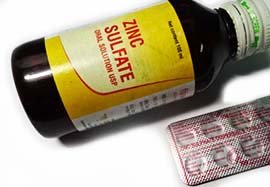Zinc deficiency
Zinc is one of the vital micronutrients required for normal metabolic functions. It is a cofactor in various enzymes and is an important nutrient involved in protein and nucleic acid synthesis. Zinc deficiency leads to growth retardation, malabsorption, diarrhea, impaired immunity, and skin changes,.
Zinc is absorbed in the small intestine. It is chiefly distributed in muscles, the liver, reproductive organs, bones, and the brain. The average human body contains about 2 g of zinc.
 |
| Zinc supplements to treat deficiency |
Functions of Zinc
Zinc is an integral component of many enzymes responsible for metabolic functions in the body. It is involved in the synthesis and stabilization of proteins, DNA, and RNA.
Zinc is necessary for the binding of steroidal hormone receptors and several other transcription factors to DNA and thereby plays an important role in the regulation of transcription.
Zinc is absolutely required for normal spermatogenesis, fetal growth, and embryonic development.
Zinc is an essential mineral required for the healthy growth of hair, nails, and skin.
It has been found to increase cell-mediated immunity.
Zinc helps in vitamin-A metabolism and normal blood levels of zinc are essential for the restoration of night vision.
Recommended dietary allowances of zinc-
| Category | Age Group | RDA |
| Infants | 0-6 months | 5 mg |
| 6-12 months | 5 mg | |
| Children | 1-10 years | 10 mg |
| Males (younger) | 11-18 years | 15 mg |
| Males (older) | 19 and above | 15 mg |
| Females | 11-50 years | 12 mg |
| 51 and above | 12 mg | |
| Pregnant woman | 15 mg | |
| Lactating Mother | 19 mg |
Causes of low zinc levels
Normal serum level is 60-150 μg%. In malnourished children values can be as low as 20-25 μg%. Its absorption is inhibited by dietary phytates, fiber, oxalate, iron, and copper as well as drugs like penicillamine, sodium valproate, and ethambutol.
Causes of poor intake and low absorption (bio-availability) of zinc:
Zinc in vegetables, fruits, and grains is less available for absorption.
Mild zinc deficiency has been described in many diseases like diabetes, AIDS, cirrhosis, alcoholism, IBD, and sickle cell disease.
Deficiency occurs in Protein-energy malnutrition (PEM), Total parenteral nutrition (TPN), hepatitis, and nephritic syndrome.
Deficiency produces thymic atrophy and serum thymulin levels can be used to detect early zinc deficiency.
Signs and symptoms of zinc deficiency
Symptoms include-
Mild chronic zinc deficiency can cause stunted growth in children
Hair fall
Dry, flaky skin
Decreased taste sensation
Delayed wound healing
Thymus gland atrophy and Impaired immune function
Night blindness (due to impaiered converion of retinol to retinoldehyde).
Severe chronic zinc deficiency has been described as a cause of hypogonadism and stunted growth (dwarfism). In children, premature graying of hair (hypopigmentation) also occurs.
Acrodermatitis enteropathica responds to zinc therapy. It produces crusting dermatitis in around the mouth (periorificial regions), bullae in palms and soles, and diarrhea.
Food sources of zinc
The sources are lamb, liver, beef, oyster, pulses, nuts, cereals, and dry fruits. Zinc supplementation has been shown to result in better catch-up in height in those with LBW and malnutrition.
Refer to the table for food sources of zinc.| Food source | Nutrient Value | Percentage of RDA |
|---|---|---|
| Animal sources | ||
| Beef, lean meat, cooked | 8.01 mg | 73% |
| Bison, game meat, cooked | 8.64 g | 78% |
| Cheese, feta | 2.88 mg | 26% |
| Chicken, cooked | 2.26 mg | 20.5% |
| Egg, whole, fried | 1.39 mg | 13% |
| Lamb, lean meat | 2.05 mg | 19% |
| Milk | 0.22 mg | 2% |
| Seafood/Mollusk | ||
| Fish, Herring | 0.99 mg | 9% |
| Spiny lobster, cooked | 7.27 mg | 66% |
| Octopus, common, raw | 1.68 mg | 15% |
| Oyester, Pacific | 16.62 mg | 151% |
| Plant sources | ||
| Fruits | ||
| Apricot, dehydrated | 1 mg | 9% |
| Currants, zante, dried | 0.66 mg | 6% | Vegetables |
| Amaranth leaves, cooked | 0.88 mg | 8% |
| Bamboo shoots, raw | 1.10 mg | 10% |
| Garlic, raw | 1.16 mg | 10% |
| Green peas, raw | 1.24 mg | 11% |
| Mushrooms, chanterelle, raw | 0.71 mg | 6% |
| Soybeens, green, raw | 0.99 µg | 9% | Nuts and seeds |
| Almonds, dry roasted | 3.13 mg | 28% |
| Hazelnuts | 2.45 mg | 22% |
| Pumpkin seeds, dried | 7.64 mg | 69% |
| Sunflower seeds, toasted | 5.21 mg | 47% |
Zinc Supplements
Zinc formulations for infants to adults are available as tablets, syrup, and lozenges to treat zinc deficiency, following physician consultation. Zinc supplements are generally advocated for reducing cold (flu) symptoms, respiratory infections, and diarrhea incidences in developing countries.
Health risks of excessive zinc intake
Acute zinc toxicity after oral ingestion causes nausea and vomiting, fever, abdominal pain, and respiratory distress. Excess can produce iron and copper deficiency. Zinc is also useful in the treatment of Wilson's disease (excess of copper levels in the body) since it inhibits the body's absorption of copper. Excess can also produce GI upset. (Medical disclaimer).
≺≺ Read on Essential fatty acids.
≺≺ Read Iron deficiency anemia.
≺≺ Back to Nutrition articles from Zinc deficiency.
Further reading and References:
National Institute of Health-Zinc Dietary Supplement Fact Sheet.
USDA Food Composition Dtabases.